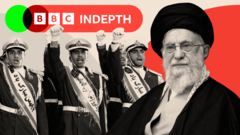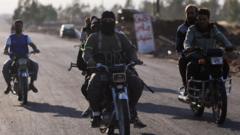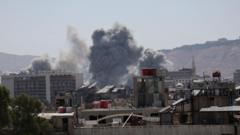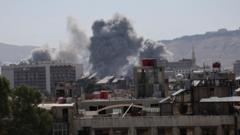The ceasefire in the war with Israel provides Ayatollah Khamenei a chance to emerge from hiding, but he will confront a devastated Iran and rising calls for leadership change amidst the chaos and dissent at both leadership levels and among the populace.
Iran's Supreme Leader Faces a New Reality After War with Israel

Iran's Supreme Leader Faces a New Reality After War with Israel
Ayatollah Ali Khamenei's prolonged absence raises questions about the future of Iran as dissent grows and war devastates the nation.
Iran's Supreme Leader, Ayatollah Ali Khamenei, 86, has remained out of sight for nearly two weeks amid ongoing conflict with Israel, reportedly fearing assassination. With a newly brokered ceasefire, he faces a transformed and weakened nation upon his potential return. Recent bombings have destroyed substantial military infrastructure, leaving the regime vulnerable.
Skepticism remains regarding the ceasefire's durability as Khamenei has been pinpointed as responsible for leading Iran to such dire straits, prompting widespread frustration among citizens. Many Iranians blame him for pursuing unattainable goals against Israel and ignoring the economic decay inflicted by years of sanctions.
During the conflict, murmurs of discontent from high-ranking officials have surfaced, with calls for a change in leadership echoing from religious scholars in Qom, independent from Khamenei's influence. The populace has shown a willingness to support each other amidst the strife, but there is simultaneous resentment toward the regime.
Public opinion indicates a longing for regime change, but resistance to foreign intervention remains prevalent. This dilemma persists as Khamenei’s reign has systematically dismantled opposition while the current climate reveals a mixture of solidarity and dissent among everyday Iranians.
While Iran’s military capabilities have suffered considerable setbacks, the remaining ballistic missile silos pose ongoing threats. Concerns over Iran's nuclear ambitions linger, as Khamenei may intensify efforts to establish nuclear weapons, particularly given recent advances in uranium enrichment.
The Supreme Leader now faces a critical juncture, aware that his health and the stability of his regime may be precarious. With potential successors at play, the internal dynamics of power could shift dramatically in the coming weeks, indicating the possibility of profound changes within Iran’s governance structure. As the war has reshaped the nation’s landscape, Khamenei must navigate the turbulent waters of a discontented citizenry and an embattled political landscape.
Skepticism remains regarding the ceasefire's durability as Khamenei has been pinpointed as responsible for leading Iran to such dire straits, prompting widespread frustration among citizens. Many Iranians blame him for pursuing unattainable goals against Israel and ignoring the economic decay inflicted by years of sanctions.
During the conflict, murmurs of discontent from high-ranking officials have surfaced, with calls for a change in leadership echoing from religious scholars in Qom, independent from Khamenei's influence. The populace has shown a willingness to support each other amidst the strife, but there is simultaneous resentment toward the regime.
Public opinion indicates a longing for regime change, but resistance to foreign intervention remains prevalent. This dilemma persists as Khamenei’s reign has systematically dismantled opposition while the current climate reveals a mixture of solidarity and dissent among everyday Iranians.
While Iran’s military capabilities have suffered considerable setbacks, the remaining ballistic missile silos pose ongoing threats. Concerns over Iran's nuclear ambitions linger, as Khamenei may intensify efforts to establish nuclear weapons, particularly given recent advances in uranium enrichment.
The Supreme Leader now faces a critical juncture, aware that his health and the stability of his regime may be precarious. With potential successors at play, the internal dynamics of power could shift dramatically in the coming weeks, indicating the possibility of profound changes within Iran’s governance structure. As the war has reshaped the nation’s landscape, Khamenei must navigate the turbulent waters of a discontented citizenry and an embattled political landscape.





















